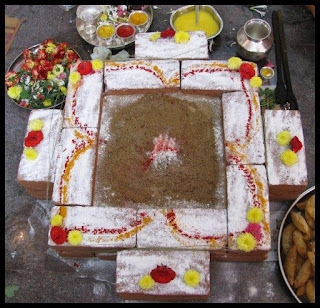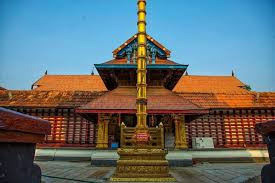As told many times earlier, Kerala is being created by Lord Parasurama. After the creation of the land, he brought several people from other parts to live here. He has constructed many temples across Kerala and designated two Brahmin Families to take care of the Tantric part of the temple activities. Tharananalloor and Thazhaman were those two families. There is an interesting myth about how those names have come to exist.
Lord Parasurama was sitting on the banks of Holy River
Pamba. At that time heads of both these families appeared on the other side of
the river. Parasurama asked both of them to come near to him immediately.
Actually, he intended to check their expertise in Tantra. When one of them
crossed the river by walking over the waves, the other one crossed it by
walking over the bed of the river. When the river stood standstill to enable
the great tantric to cross by walking over it, it paved way for the other by
keeping the water away from his way. The one who crossed the river by walking
over it came to be known as Tharananalloor as he crossed it walking over it. The
other one who walked over the river bed (Thazhe mannu in local language
Malayalam means the sand beneath) came to be known as Thazheman.
Pleased with their expertise, Parasurama allotted the right
of Tantra in all Sastha Temples to Thazhaman family and that of Devi temples to
Tharananalloor family. As there were temples of other gods, these have been
divided among them equally. However,
Tharananalloor Namboothiri, as the head of the family used to be known, had the
rights of Tantra in different temples even outside Kerala too. He had the right
to perform tantric rituals in the famous Madhura Meenakshi Temple in Tamil
Nadu. He used to perform the rituals during the Kalabham Ceremony which has
been conducted every year.
Once the administration of the temple has fallen in the
hands of some new generation people who were not religious as much their
predecessors were. They raised the necessity of performing the Kalabham ceremony
every year after spending a huge amount. When the Tharananalloor Namboodiri came
that year to perform rituals, the temple administrator demanded that he should
be able to see Goddess Devi in person.
Namboodiri tried to deviate his attention to other things so that he will not insist on it again. But the administrator stuck to his
demand. Then Namboodiri told him that he can peep through the temple doors when
Namboodiri performs the rituals after closing the doors. Namboodiri also warned
him that he will not be responsible for any unwanted things if something
happens. Administrator agreed.
In the evening, when Namboodiri entered the temple for
performing tantric rituals after closing the door, the administrator came in
front of the door and peeped through the gap in between the two doors. He saw
the ferocious form of Devi through the gap and fell down unconscious. Hearing
his loud cry other people from the temple office came there and took the man
away to the hospital. Although the hospital authorities tried their level best,
he lost his eyesight and had to live as blind for the remaining life. Namboodiri
did not know all these happenings and when he came out, people narrated him the
entire incidents. He turned towards the sanctum sanctorum and told loudly.
“Oh, Goddess Ma, Now I am performing the rituals here. I am
not sure whether my predecessors can do it or not. So I am surrendering my
right to perform the rituals in this temple.” Thus Tharananalloor family ceased
to be the Tantri of Madhura Meenakshi Temple.
There are many stories about the performances of different
Tharananalloor Namboodiripads, who were the heads of the family at different
periods. Since it will consume too much of space, only one such story is being
narrated here.
Once, the Namboodiri, then head of the family went to have a bath in the family pond. It was early in the morning and there prevailed
silence in the atmosphere. Suddenly he heard a loud cry from the other side of
the pond and sent his servant to enquire about it. The servant returned and told
Namboodiri that Neelakandan, who was residing on the other side of the pond
died due to snakebite and it was the cry of his wife and children they heard.
Then Namboodiri told his servant that Neelakandan has not died and ask him to
bring the body there.
Neelakandan’s family members brought the body to the pond
side. He asked them to keep the body in an open space. Then He waited near the
body holding a small stick in his hand. Hours have passed and nothing happened.
Villagers started gathering at the place and there were some rationalists also
among them. They started kidding Namboodiri. Still, he waited there holding the stick
and did not try to answer anybody’s queries.
After a few hours, a snake came there and raised its hood as
if extending pleasantries with Namboodiri. Immediately Namboodiri asked his
servant to bring milk and coconut water in two separate bowls. They have been
brought and kept on both sides of the body of Neelakandan. After that,
Namboodiri turned towards the snake and told it.
“Take it back.” The snake went near the body of Neelakandan and
bitted once again on his legs. It kept its teeth for quite some time and then
came near Namboodiri. Namboodiri told it not to worry as he has kept milk
there, it can dip its head in it. The snake did the same and to the utter shock of
the crowd gathered there, the color of the milk turned blue. Namboodiri again
instructed him to take back the poison and the snake obeyed it. This time
Namboodiri asked the snake to dip the head in the bowl of coconut water and
that too turned blue. When the snake finished sucking poison from the body of
Neelakandan, Namboodiri broke the stick he was holding in his hand. Everybody
presented there surprised to see the body of the snake get breaking into two
pieces. And adding more glory to the occasion, Neelakandan Woke up as if he
was asleep.
By that time, Neelakandan’s relatives have made all arrangements
for his cremation. The body of the snake has been cremated at that place and
Namboodiri performed all rituals standing in the place of the snake’s son. He even
observed the Deeksha (A ritual to be observed by the eldest son after the death
of father) for a year.









